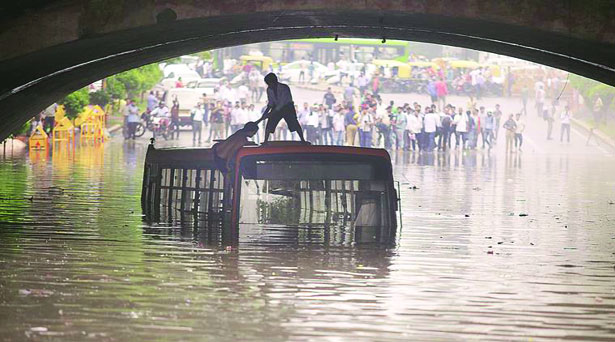Traffic snarls, waterlogging and the loss of lives show that a manageable issue has been allowed to deteriorate
Amid the pall of gloom cast by COVID-19 and the oppressive heat, India was earnestly looking forward to the arrival of the monsoon. The Indian Meteorological Department (IMD) had forecast surplus rainfall in various parts of the country and sure enough, metropolises such as Mumbai and Delhi have received a healthy share of showers.
Mumbai, for instance, received 26 per cent more rainfall as compared to last year, while Delhi received 70 mm of rain on July 19 alone, which is the highest in the last five years. But no matter how heartening the rains might be, every passing year they bring in their wake the ever-growing problem of urban flooding.
This has been experienced for decades in India but sufficient attention has not been given to specific efforts to deal with it. In the past, any strategy on flood disaster management largely focussed on riverine floods affecting large extents of rural areas. Urban flooding is significantly different from rural flooding as urbanisation leads to developed catchments and in the event of heavy/high intensity rainfall, there is higher run-off, which increases the flood peaks from 1.8 to eight times and flood volumes up to six times. Consequently, flooding occurs very quickly due to faster flow times, sometimes in a matter of minutes.
The recent death of a mini-truck driver after his vehicle got submerged under the Minto Bridge after a spell of rain in Central Delhi underlines the growing threat of urban flooding. While most of the time urban India patiently endures huge volumes of flooding and the resultant traffic snarls, when people start losing lives, it is time for the citizens and the authorities to consider the problem seriously and deal with it effectively.
Though large cities like Mumbai, Delhi and Chennai go through urban flooding annually, the recurrence of the problem suggests that no lessons are learnt and no infrastructure is built or improved to prevent it. Just a few hours of hard rain in metropolitan cities can present a very embarrassing spectacle as daily life is thrown out of gear and the cities become unwitting examples for the developed world to learn from. Another concerning aspect is that urban flooding increases the chances of contagious diseases like typhoid, cholera, leptospirosis, hepatitis and even COVID-19 spreading far more easily. For instance, floodwaters in Assam spread discarded medical waste and used PPE from hospitals and COVID-19 care centres, raising fears of infection among people in inundated areas.
One of the major reasons for urban waterlogging are the archaic sewer systems in our cities that are heavily choked with silt and garbage. Indian metros not only need regular cleaning of sewers and storm water drains, particularly before the onset of the rainy season, they also require an advanced system that is based on the latest technology and satellite data that can calculate the quantities of water run-off every monsoon and accordingly estimate the load factor on the sewerage and storm water system.
Another reason for flooding of cities is excessive concretisation and paved areas in the urban landscape. This has not only resulted in exacerbating the heat island effect and causing a sharp spike in ambient temperatures but preventing rainwater absorption into the ground and recharging of the water table. This, too, increases the rainwater run-off, putting undue pressure on the drainage network.
The efforts to prevent urban flooding will be incomplete unless the ground water absorption rate of rainwater as compared to the run-off rate is balanced. Another issue pertaining to urban flooding is the role played by illegal construction and how it is impacting the storm water drainage system across India’s major cities. As urban sprawls increase rapidly, unauthorised construction and unplanned digging by civic agencies are becoming two major issues that are further impacting our already overburdened drainage systems adversely. Flooding will continue to trouble urban citizens unless these impediments are addressed and removed.
We often marvel at infrastructure planning of ancient India, especially the drainage system of the Mohenjo-Daro and Harappa cultures that date back to 2400 BC. Sadly we are unable to replicate the excellence and success of the bygone era in today’s time. Urban flooding is avoidable and in order to ensure safety of lives and property, it is essential for the Government to rapidly develop strategies that draw from the best of the world’s benchmarking practices in urban rainwater management. We need city-wise protocols that cater to the typicality of the demographics and geography and automatically kick in when the area receives a certain quantum of rainfall.
Traffic snarls, waterlogging and the loss of lives due to urban flooding are a painful indication that a manageable issue has been allowed to deteriorate and get out of hand. It is time authorities around the country wake up.
(The writer is an environmental journalist)


























